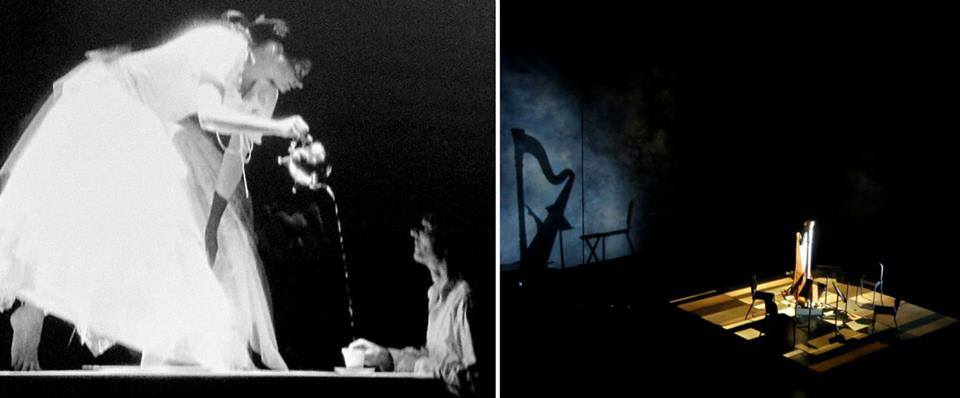It was interesting, recently, to see two stage treatments of the works, and in one case the life, of Edgar Allan Poe. Interesting, that is, in the differences and similarities between them and in the fact of their synchronicity. Each was flawed, but memorable, both singly and, by fortuity, paired. Each set Poe’s poetry to music, but one was a stage play, with characters and incidents from Poe’s life, and styles ranging from folk to art song to flamenco; the other was operatic, an extended lied of a single poem, with an instrumental prologue based on one of the stories, and utterly abstract in its staging. They each composed an atmosphere of light and shadow, the former of dark nights and lamplight, the latter of long shadows and precisely lighted surfaces. In both cases – and this is the most striking parallel – there was a silent dancer, in the first case representing the spirit of Poe’s child wife, in the second some less defined feminine entity, but certainly including a yearned for, but departed, woman or girl. Where this pendulum is swinging is between RED-EYE TO HAVRE DE GRACE, which I saw at the New York Theatre Workshop, and THE RAVEN, as performed by the Gotham Chamber Opera.
HAVRE was an ensemble co-creation, under the direction of Thaddeus Phillips, and charts the last days of Poe’s life, from a talk he gave to a literary club in Philadelphia to the wrong train he took in trying to get back to New York to prepare for his second wedding. The whole was narrated by a Wilderesque stage manager in the form of a Park Ranger from a Poe site in Philly, and tied together on a deeper level by a remarkably fluid dancer representing the deceased wife and her poetic manifestation in such figures as Annabel Lee and Lenore. Ean Sheehy looked a lot like Poe, and, once the reediness of his voice faded, was both touching and convincing. Alessandra Larsen could not have been better as the shade of Virginia, who finds in death an assertiveness that the real child bride must not have had in life. The play did not solve the mystery of Poe’s death, but gave it a very great poignancy, of the sort implied by the title if the slang and the French are rendered in plain English: “Night train to haven of grace.”
Across town, Tosio Hosokawa’s THE RAVEN was sung, after the playing of André Caplet’s Conte fantastique: La masque de la mort rouge (Masque of the Red Death), by the mezzo-soprano Fredika Brillembourg, and danced by the exquisitely spindle-legged Alessandra Ferri (yes, both dancers were named Alessandra). The which was sensitively accomplished and beautifully staged, with special credit to Clifton Taylor’s lighting and its interaction with the set, co-designed with Luca Veggetti.
So what about these two productions was flawed? In the case of RED-EYE TO HAVRE DE GRACE, one of the very things that made it lively and innovative – the diversity of genre that included setting Poe’s “El Dorado” to flamenco – sometimes felt like a hodgepodge that needed to be sorted out. And turning the THE RAVEN into an extended art song made me yearn, oddly, for the singsong of the original, which is – I say this as an admirer – one of Poe’s hoariest. The meter is so familiar that imposing a new one on it seemed almost to question the value of the material being sung. RED-EYE TO HAVRE DE GRACE at all points scanned the verse accurately, whether it was crude or profound. Lieder are, I understand, a peculiar form in this regard, running roughshod but beautifully over the poet’s intent, but I could not, listening to THE RAVEN, fully reconcile myself to the elision of a rhythm so deeply ingrained.
Click here for information on Gotham Chamber Opera programs and events. For more on Lucidity Suitcase International, the creative team behind RED-EYE TO HAVRE DE GRACE, click here. Go to New York Theatre Workshop for future events at that venue.
